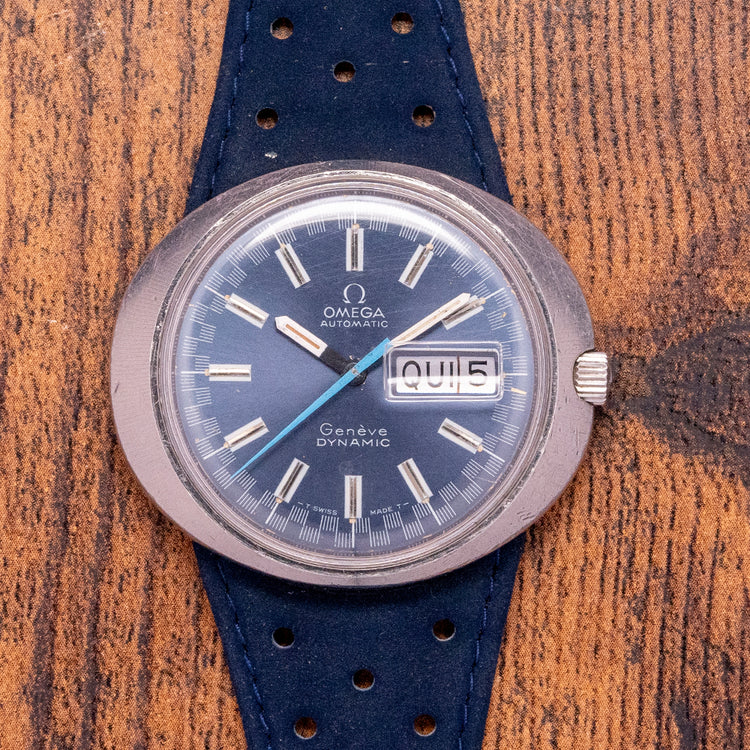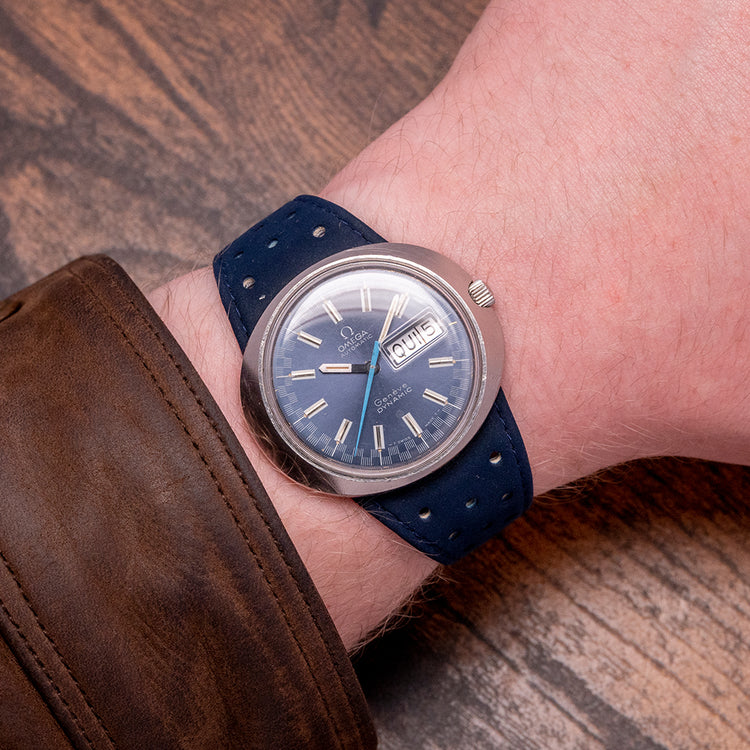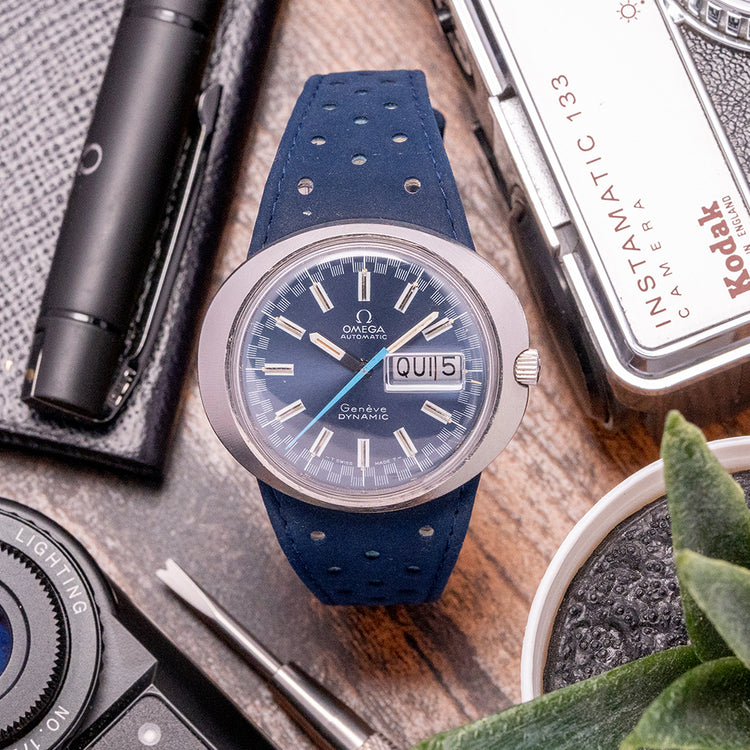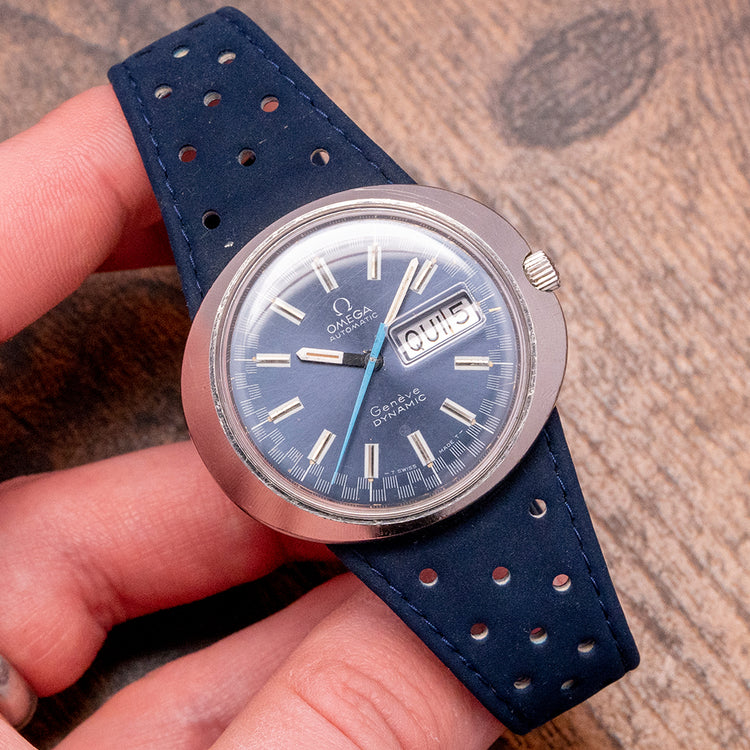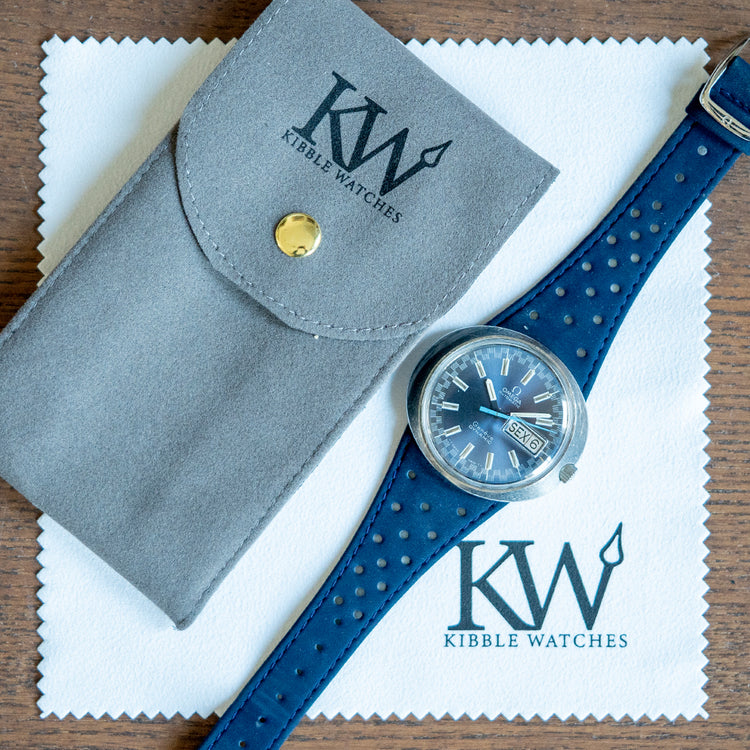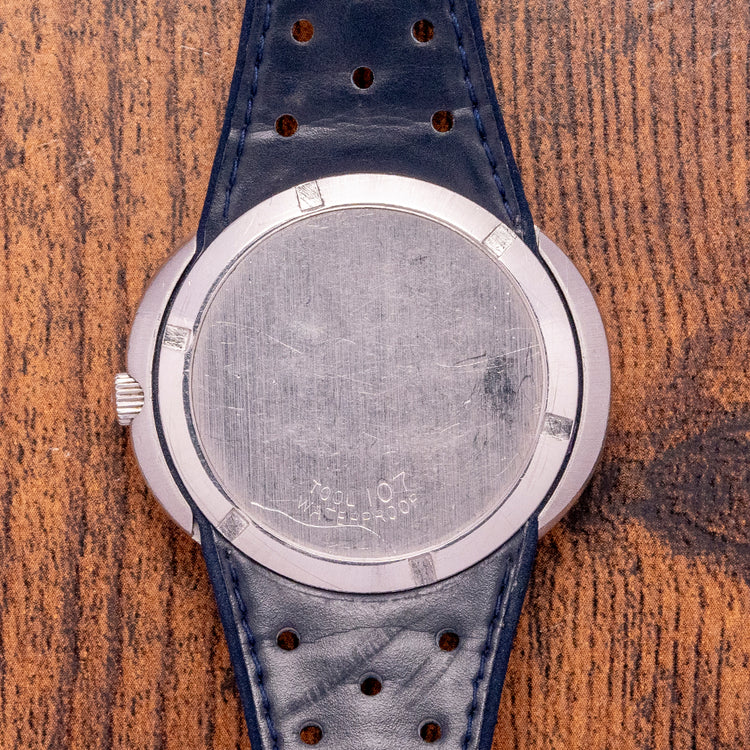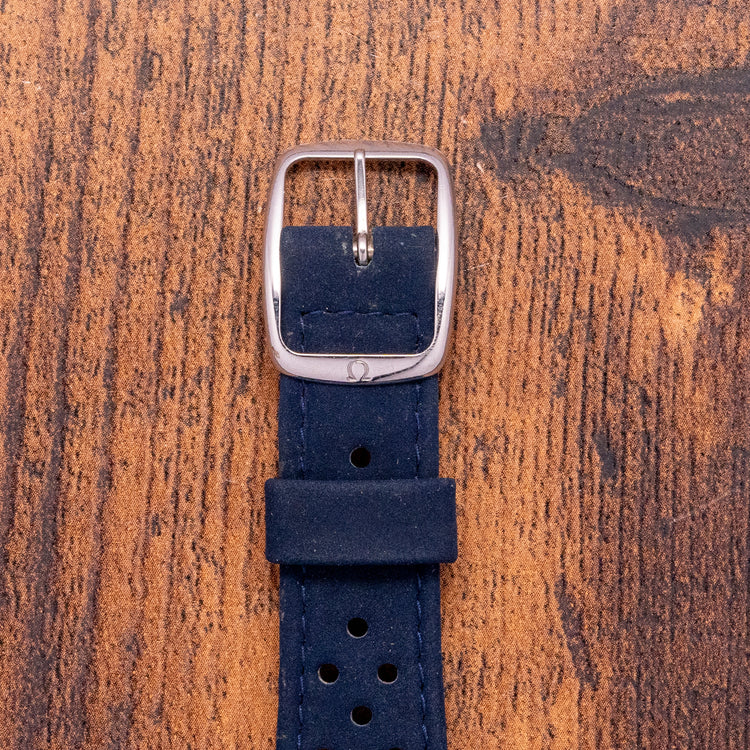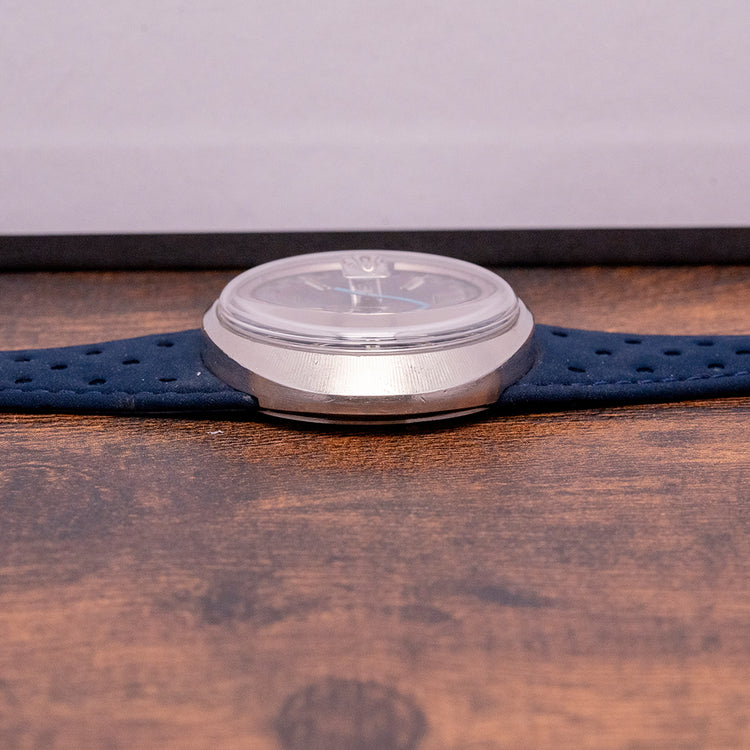More Information
Description
More
Less
The Watch
The Omega Genève Dynamic was introduced in 1967 and launched in 1968, Raymond Thévenaz designed the collection. Dynamic, refers to the unique shape of the case, after an in-depth study of the way a watch sits on a wrist and the Dynamic line became a success and went on for a number of years. The unique case shape is an ellipse, though the dial and the movement are round, Fernando Fontana (Sesto Calende), an Italian case maker, designed and produced this case for Omega. Here we have a 1969 Omega Dynamic Day Date Automatic Blue Racing 166.079 with a 41.5mm stainless steel ellipse (UFO) shape case, at 36mm lug-to-lug and a thickness of 11.5mm, you can be sure of a comfortable fit. The case is a monocoque (coque in French means hull) case design, made from a solid piece of brushed stainless steel, access to the movement is by removing the crystal with a special tool. On the right side, is a signed recessed crown. A domed crystal sits above a blue dial and a white chequer pattern outer minute track is precisely printed, slim painted white bordered steel baton indexes mark the hours, at 3 o’clock a day/date window with a cyclops magnification on the crystal, baton white hands with Tritium infill complemented by a blue central seconds hand. On the reverse, a screw back that holds only the strap in place, as you take the movement out from the front, inside an automatic Omega Cal. 752, 24 jewels, beating at 19,800 beats per hour. The watch comes paired with its original 25mm Omega integrated blue suede racing-style strap and signed pin buckle.
Points of Mention
This watch is sold as "Watch Only" and therefore comes with no original Omega box or paperwork. The watch comes paired with an original 25mm Omega integrated blue suede racing-style strap and signed pin buckle. The watch is from Circa. 1969 and is sold in worn, vintage condition and remains in all original and fair condition for its age, as you can see. The watch comes with our 12-Months NON-Waterproof Warranty.
For more photos see here - https://drive.google.com/drive/folders/17QvnkQ2DIr59tQKIFtXhCVfvxeqZBvv9?usp=drive_link
4K YouTube video, skip to 23:20 - https://youtu.be/PrW6AGaFoX0
Personal Note
The Omega Dynamic is without question one of my favourite vintage Omega references, yet I rarely get them in stock and this is due to the fact all the great ones are taken up and being enjoyed by collectors, so when the opportunity comes to get a nice one, I always jump at it! This wonderful blue racing dial day date 166.079 is a beautiful example ready to be worn and enjoyed, paired on its original blue strap with a signed buckle, it doesn't get much better than this for the price!
Specification
Lugs : 25mm
Condition : Pre-Owned
Box & Papers : None
Case Material : Stainless Steel
Warranty : 12-Months NON-Waterproof Warranty
The Brand
They were formerly known as the La Generale Watch Co. in 1848 founded by Louis Brandt in La Chaux-de-Fonds. When he died in 1879, his sons carried on his dream. In 1880 they moved to 96 Rue Jakob-Stampfli where they remain today. The brothers produced their first mass-produced calibre, the Labrador In 1885. Just a few years later in 1892, they produced the first minute-repeater. In 1903 they renamed the company Omega until 1982 when they officially changed their name to Omega SA. During WW1 Omega watches were used as official timekeepers for the Royal Flying Corps and the US Army. In 1930, Omega and Tissot merged together to form Société Suisse pour l'Industrie Horlogère (SSIH) In 1931, another group was formed - Allgemeine Schweizerische Uhrenindustrie AG (ASUAG). Where SSIH was primarily French-speaking, ASUAG was founded by the more German-speaking members of the Swiss watch industry. In 1948 they introduced the first edition of one of its most symbolic watches: the Seamaster. Omega first introduced the Constellation in 1952. At the time it was Omega's flagship timepiece. The first models had a Cal. 354 bumper movement in them. Later in 1955, Omega introduced the Automatic Cal. 50x, followed in 1959 by the Cal.55x (no date) and 56x (date) versions. Many of the Constellations came with pie-pan dials, diamond indexes, and fancy lug configurations. All the gold Constellations of that time have the Observatory of Geneva's hand engraved on the back. The stainless steel and stainless steel/gold versions had a gold medallion on the back with the Observatory of Geneva. The eight stars above the Observatory stand for the many exploits of Omega in the world Chronometer competition. Celebrating the fact that all Constellations are Chronometer Certified. In 1962, when astronaut Wally Schirra wore a Speedmaster on his Mercury Sigma 7 Mission, making it the first Omega watch to enter space. After rigorous tests, NASA used Omega for all their Apollo missions including the 1969 Moon landing of Apollo 11. Today Omega is still an astronaut's first choice. In 1969, President Nixon famously said it was “too valuable” and turned down the first-ever all-gold Speedmaster Professional Deluxe. As a response to the ever-growing threat of electronic watches to the manufacturers of mechanical watches, Omega and many Swiss brands such as Rolex and Patek Philippe formed Centre Electronique Horologer (CEH). Prototypes began to appear in 1967 with their production starting in 1968. Then In 1972, Omega introduced the reference, 198.030, which included the Omega calibre 1250, a ‘tuning-fork electronic movement which was made under licence from Bulova. Later we saw a merger of SSIH and ASUAG into SMH, or Société de Microélectronique et d’Horlogerie. This merger took place in 1983. In 1992, the company acquired Blancpain, and in 1998 it officially rebranded itself from SMH to the Swatch Group. Then, in 1999, they purchased and integrated Breguet into the Swatch Group.
Points of Mention
More
Less
Personal Note
More
Less
Specification
More
Less
Movement : Automatic Omega Cal. 752
Year : 1969
Case Size : 40mm
Case Thickness : 11.5 mm
Lug to Lug : 36mm
Lugs : 25mm
Condition : Pre-Owned
Box and Papers : None
Case Material : Stainless Steel
Warranty : 12-Months NON-Waterproof Warranty
The wrist model's wrist size is 7inch
About Omega
More
Less
Description
The Watch
The Omega Genève Dynamic was introduced in 1967 and launched in 1968, Raymond Thévenaz designed the collection. Dynamic, refers to the unique shape of the case, after an in-depth study of the way a watch sits on a wrist and the Dynamic line became a success and went on for a number of years. The unique case shape is an ellipse, though the dial and the movement are round, Fernando Fontana (Sesto Calende), an Italian case maker, designed and produced this case for Omega. Here we have a 1969 Omega Dynamic Day Date Automatic Blue Racing 166.079 with a 41.5mm stainless steel ellipse (UFO) shape case, at 36mm lug-to-lug and a thickness of 11.5mm, you can be sure of a comfortable fit. The case is a monocoque (coque in French means hull) case design, made from a solid piece of brushed stainless steel, access to the movement is by removing the crystal with a special tool. On the right side, is a signed recessed crown. A domed crystal sits above a blue dial and a white chequer pattern outer minute track is precisely printed, slim painted white bordered steel baton indexes mark the hours, at 3 o’clock a day/date window with a cyclops magnification on the crystal, baton white hands with Tritium infill complemented by a blue central seconds hand. On the reverse, a screw back that holds only the strap in place, as you take the movement out from the front, inside an automatic Omega Cal. 752, 24 jewels, beating at 19,800 beats per hour. The watch comes paired with its original 25mm Omega integrated blue suede racing-style strap and signed pin buckle.
Points of Mention
This watch is sold as "Watch Only" and therefore comes with no original Omega box or paperwork. The watch comes paired with an original 25mm Omega integrated blue suede racing-style strap and signed pin buckle. The watch is from Circa. 1969 and is sold in worn, vintage condition and remains in all original and fair condition for its age, as you can see. The watch comes with our 12-Months NON-Waterproof Warranty.
For more photos see here - https://drive.google.com/drive/folders/17QvnkQ2DIr59tQKIFtXhCVfvxeqZBvv9?usp=drive_link
4K YouTube video, skip to 23:20 - https://youtu.be/PrW6AGaFoX0
Personal Note
The Omega Dynamic is without question one of my favourite vintage Omega references, yet I rarely get them in stock and this is due to the fact all the great ones are taken up and being enjoyed by collectors, so when the opportunity comes to get a nice one, I always jump at it! This wonderful blue racing dial day date 166.079 is a beautiful example ready to be worn and enjoyed, paired on its original blue strap with a signed buckle, it doesn't get much better than this for the price!
Specification
Lugs : 25mm
Condition : Pre-Owned
Box & Papers : None
Case Material : Stainless Steel
Warranty : 12-Months NON-Waterproof Warranty
The Brand
They were formerly known as the La Generale Watch Co. in 1848 founded by Louis Brandt in La Chaux-de-Fonds. When he died in 1879, his sons carried on his dream. In 1880 they moved to 96 Rue Jakob-Stampfli where they remain today. The brothers produced their first mass-produced calibre, the Labrador In 1885. Just a few years later in 1892, they produced the first minute-repeater. In 1903 they renamed the company Omega until 1982 when they officially changed their name to Omega SA. During WW1 Omega watches were used as official timekeepers for the Royal Flying Corps and the US Army. In 1930, Omega and Tissot merged together to form Société Suisse pour l'Industrie Horlogère (SSIH) In 1931, another group was formed - Allgemeine Schweizerische Uhrenindustrie AG (ASUAG). Where SSIH was primarily French-speaking, ASUAG was founded by the more German-speaking members of the Swiss watch industry. In 1948 they introduced the first edition of one of its most symbolic watches: the Seamaster. Omega first introduced the Constellation in 1952. At the time it was Omega's flagship timepiece. The first models had a Cal. 354 bumper movement in them. Later in 1955, Omega introduced the Automatic Cal. 50x, followed in 1959 by the Cal.55x (no date) and 56x (date) versions. Many of the Constellations came with pie-pan dials, diamond indexes, and fancy lug configurations. All the gold Constellations of that time have the Observatory of Geneva's hand engraved on the back. The stainless steel and stainless steel/gold versions had a gold medallion on the back with the Observatory of Geneva. The eight stars above the Observatory stand for the many exploits of Omega in the world Chronometer competition. Celebrating the fact that all Constellations are Chronometer Certified. In 1962, when astronaut Wally Schirra wore a Speedmaster on his Mercury Sigma 7 Mission, making it the first Omega watch to enter space. After rigorous tests, NASA used Omega for all their Apollo missions including the 1969 Moon landing of Apollo 11. Today Omega is still an astronaut's first choice. In 1969, President Nixon famously said it was “too valuable” and turned down the first-ever all-gold Speedmaster Professional Deluxe. As a response to the ever-growing threat of electronic watches to the manufacturers of mechanical watches, Omega and many Swiss brands such as Rolex and Patek Philippe formed Centre Electronique Horologer (CEH). Prototypes began to appear in 1967 with their production starting in 1968. Then In 1972, Omega introduced the reference, 198.030, which included the Omega calibre 1250, a ‘tuning-fork electronic movement which was made under licence from Bulova. Later we saw a merger of SSIH and ASUAG into SMH, or Société de Microélectronique et d’Horlogerie. This merger took place in 1983. In 1992, the company acquired Blancpain, and in 1998 it officially rebranded itself from SMH to the Swatch Group. Then, in 1999, they purchased and integrated Breguet into the Swatch Group.
Points of Mention
Personal Note
Specification
The Brand
Enquire or Book an Appointment
Would you like to discover further details about this watch, or perhaps arrange an appointment to view and try it on? Complete this form and a member of our team will get back to you shortly.
You May Also Like




















